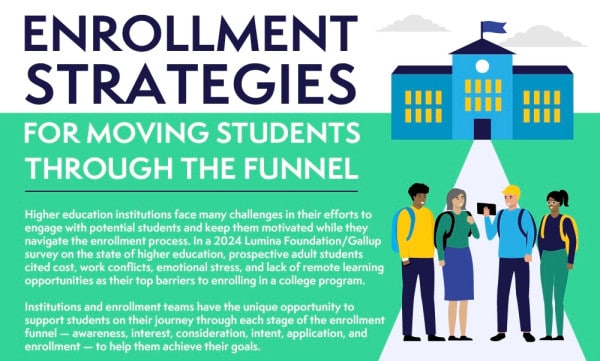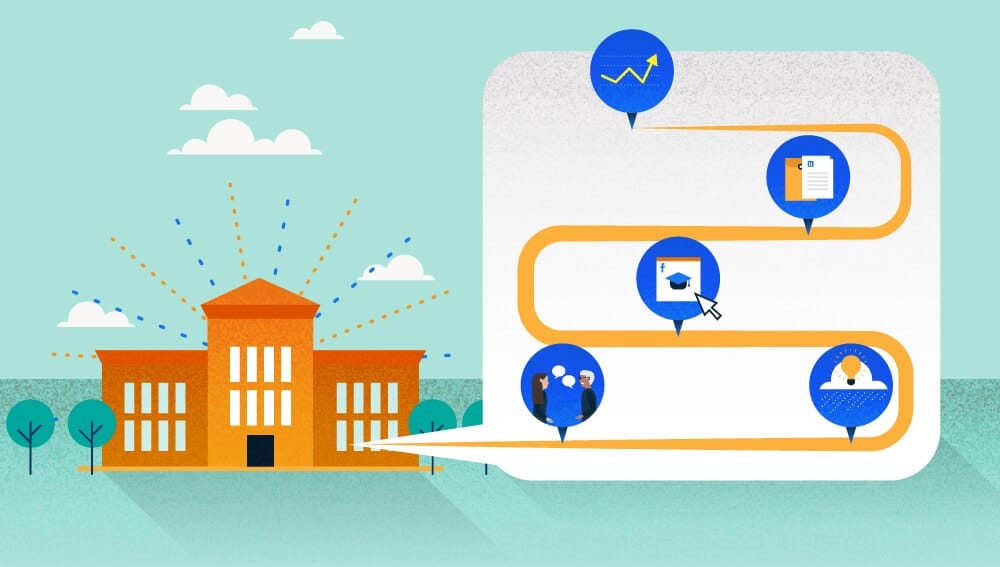
Social media has been a mainstay of your student recruitment strategy for years now, and that isn’t going to change: Facebook and Instagram in particular are still extremely effective recruitment platforms for savvy colleges and universities. The tactics you implemented a few years ago, however, won’t continue producing the results you need. Today, your social media reach is largely dependent on your investment. Last year, the average organic Facebook page post reached just eight percent of its audience, according to Hootsuite, while paid posts reached more than 25 percent of the total audience – more than a 300 percent increase. Without putting money behind your social media efforts, it’s likely that your posts will never even be seen.
Being Seen Is Just The First Step
Once you invest in this exponentially increased reach, the quality of your posts is as important as ever. If you funnel budget toward social media campaigns without re-evaluating your creative approach, you run the risk of wasting time, money and energy on posts that just don’t speak to your prospects. Make sure your paid social makes an impression on the audience it reaches by understanding how to effectively use these channels to market to students in 2019.
Here are four easy ways to make sure your Facebook and Instagram marketing efforts have the greatest impact:
1. More Storytelling. Less Selling.

Instagram and Facebook users are inundated by hundreds of ads on the platforms every day. This means it’s easy for your prospective students to overlook branded content that isn’t personal, unique, and relevant to them. You can create this type of content by focusing on teaching a prospect something new – like educating them about the real value of a degree from your institution, for example.
“Taking the educational approach means doing more teaching than selling,” says Thrivehive. “Storytelling is not much different and, in fact, can be educational in nature. However, the power of storytelling lies not in teaching people things they didn’t know, but in relatable characters and situations, or at least characters and situations that evoke emotional responses. Such responses spur action, often much more effectively than shameless and constant self-promotion on social media.”
We recommend using video as the basis when crafting a genuine storytelling approach. Not only is it a great way to grab users’ attention and breathe life into your brand, it also works incredibly well. Videos are a consumers’ favorite type of content to see from a brand on social media, according to 2018 Animoto research, and more than half of consumers want to see more video content from a brand or business they support, according to HubSpot.
When you use video of real people, places and outcomes to capture prospect attention, you can tell stories that speak to them amid a sea of boring branding.
2. Leverage The Power Of Lookalikes.

Facebook’s lookalike custom audience tool is a great way for colleges and universities to connect with new, untapped audiences of prospective students, because it works by finding people just like those who are already attending your school. According to Facebook, a lookalike audience is “a way to reach new people who are likely to be interested in your business because they’re similar to your best existing customers.”
Start by creating a source audience and Facebook will identify the common qualities of people within it, then use that data to find people similar to them. At Archer, we utilize our first-party audience data, consisting of more than 4 million unique users per month, along with our clients’ targeting parameters to create custom lookalike audiences on social platforms. This type of campaign (we call it Social Audience Targeting) has been highly effective for our partner schools, because it reaches an untapped market of students who are interested in the types of programs our clients offer, but not familiar with our partner school’s brand. In fact, we recently helped one partner institution double their application volume while lowering costs by 21% for some programs with a Social Audience Targeting campaign.
3. Create Strategic Instagram Story Highlights.

Take advantage of your ability to save, archive and categorize Instagram stories by creating strategic highlights that act like a mini website. Think about all the reasons a student may be considering going back to school, and what might be holding them back, and create a highlight around each of the reasons. For example: Finances, flexibility, student life and career opportunities.
When your Instagram story highlights provide real value and information to prospects, you can leverage Instagram’s “link in bio” feature as a direct call-to-action – leading right to a form where students can provide their information to learn more. Facebook Stories are newer than Instagram Stories, and don’t currently have all the same capabilities. Still, we’ve seen initial success in testing Facebook Story ads for colleges and universities as well, as we outlined earlier this year.
4. Captioning Is Crucial.

You already know that video is one of the best ways (if not the best way) to capture a prospect’s attention as he’s scrolling. But did you know that 85% of users watch Facebook videos without sound? Or that Facebook says 76% of video ads require sound to be understood? Stand out by making your videos part of the 24% that are relevant without being noisy by captioning them.
Facebook research shows that captioning videos increases average video view times by 12%, and that messaging effectiveness jumps from 18% with sound on and no captions, to 82% with captions. Facebook does offer auto-captioning for video, but we recommend creating your own transcripts for ensured accuracy.

Video captions not only increase engagement across the board, but increase accessibility to your institution for prospects with hearing loss, as well. And captioning for accessibility doesn’t just apply to videos – providing a description of your Instagram or Facebook photos in the caption will increase accessibility for people with vision impairments who use speech readers – software that translates text into synthetic speech – so they can understand what’s going on in your photos.



